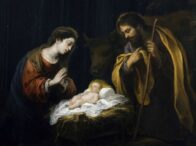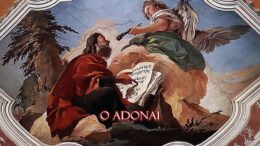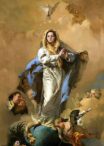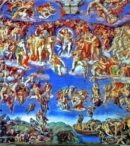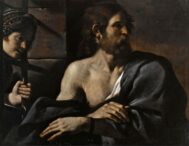The liturgical color on this day is violet. That should immediately call to mind Mass XVII (for the Sundays of Advent and Lent),and indeed, that is what we sang. There are two versions of the Kyrie for Mass XVII. We arbitrarily chose the second version. Those of you present in the congregation will have noticed that it had a rather different sound to it. The schola sang it in an ancient style of harmony referred to as parallel organum in which the same melody is sung in two voices at an interval of one fifth. This gives it a characteristic ring which people often remark gives it a very medieval sound. (It’s not exactly clear how they would know that, but that is what we often hear.)
We paired that with Credo I.
Something else to notice when the priest wears violet: The organ is silent. And so, all the music of the day was sung a cappella – unaccompanied.
Perhaps those present also noticed that the Introit was preceded by a bit of chant that is not in your missal, referred to as a trope. A trope, in liturgical music, is a musical text written for the purpose of amplifying and embellishing an otherwise complete liturgical text. In this instance, the trope was used to introduce the day’s Introit, and, in effect, to introduce the entire liturgical year of Gregorian Chant. Here is a translation of the words:
When the most holy Gregory poured out prayers to the Lord that He might surrender to him from above a musical gift in song, then the Holy Spirit descended upon him in the form of a dove and enlightened his heart to such a degree that at last he began to sing saying thus:
We then continued directly singing the introit: Ad te levavi…
For the processional, we sang O Come, O Come, Emmanuel, rather a staple for the season.
At the Offertory, we sang Rorate Coeli Desuper. This is a very beautiful hymn, the text of which is taken from the Book of Isaias. It is a hymn of sorrow and repentance, sung during Advent to help us keep before our eyes the coming of Christ, not only In the Nativity, but also in his second coming. The words and the melody are evocative of the Improperia (Reproaches) of Good Friday, which are also drawn from Isaias (and Jeremias), and cannot help but remind us that this Child was born unto us to die for us.
But wait! At the Communion – the Dies Irae? But, isn’t that for the Requiem Mass! Why would we sing it during Advent!?
As Father pointed out in his homily, the season of Advent, and thus also the new Liturgical year, begin with the theme of the end times. This is from the Gospel of the day:
At that time Jesus said to His disciples: There shall be signs in the sun, and in the moon, and in the stars; and upon the earth distress of nations, by reason of the confusion of the roaring of the sea and of the waves: men withering away for fear and expectation of what shall come upon the whole world. For the powers of heaven shall be moved. And then they shall see the Son of Man coming in a cloud with great power and majesty. But when these things begin to come to pass, look up and lift up your heads, because your redemption is at hand. … So you also, when you shall see these things come to pass, know that the kingdom of God is at hand.
The Dies Irae speaks exactly to those same themes. This is how it begins:
Day of wrath! O day of mourning!
See fulfilled the prophets’ warning,
Heaven and earth in ashes burning!
Oh, what fear man’s bosom rendeth,
When from heaven the Judge descendeth,
On whose sentence all dependeth.
Wondrous sound the trumpet flingeth;
Through earth’s sepulchres it ringeth;
All before the throne it bringeth.
For the recessional, we sang that other staple of the season, Hark a Herald Voice is Calling.

